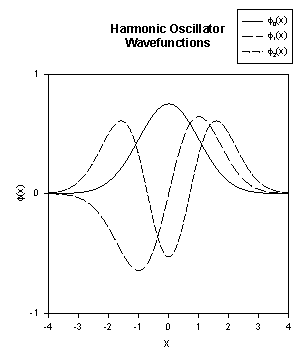

We have already found the ground state wave function, Φ0(x)
= Cexp(-½mωx2/ħ).
If we require the wave function to be properly normalized, i.e. ∫-∞∞|Φ0(x)
|2dx = 1,
then |C|2∫-∞∞exp(-mωx2/ħ)dx
= 1, |C|2(πħ/(mω))1/2 = 1, C = (mω/(πħ))1/4.
Therefore
Φ0(x)
= (mω/(πħ))1/4exp(-½mωx2/ħ).
We have previously shown that |Φn> = (n!)-1/2(a†)n|Φ0>,
<x|Φn> =
Φn(x) = (n!)-1/2<x|(a†)n|Φ0>,
a†
= (mω/(2ħ))1/2(X - iP/(mω)).
We therefore have
<x|(a†)n|Φ0> = <x|a†(a†)n-1|Φ0>
= ((n+1)!)1/2 <x|a†|Φn-1>
= ((n+1)!)1/2[(mω/(2ħ))1/2<x|X|Φn-1>
- (i/(2mωħ)1/2)<x|P|Φn-1>]
= ((n+1)!)1/2[(mω/(2ħ))1/2xΦn-1(x) -
(i/(2mωħ)1/2)(ħ/i)∂/∂x)Φn-1(x)].
or
Φn(x) = n-1/2[(mω/(2ħ))1/2x - (ħ/(2mω)1/2)∂/∂x]Φn-1(x),
Φn(x) = (n!)-1/2[(mω/(2ħ))1/2x - (ħ/(2mω)1/2)∂/∂x]nΦ0(x).
Φn(x) = (n! 2n)-1/2(ħ/(mω))n/2(mω/(πħ))1/4 [ (mω/ħ)x - ∂/∂x]n
exp(-½mωx2/ħ).
or
Φn(η) = (n! 2n)-1/2 β/√π)1/2(η
- ∂/∂η)n exp(-½η2),
where η = (mω/ħ)1/2 x = βx.
Φn(x) is the product of exp(-½mωx2/ħ) and a polynomial of degree n and
parity (-1)n called a Hermite polynomial.
Specifically,
Φ1(x) = ((4/π)(mω/ħ)3)1/4 x exp(-½mωx2/ħ),
Φ2(x) = (mω/(4πħ))1/4 [2mωx2/ħ
- 1] exp(-½mωx2/ħ).

with mω/ħ = 1.
Link: Harmonic oscillator wavefunctions
Hn(z) is a nth degree polynomial in z.
Proof:
This statement holds for n = 1 and n = 2.
Let F(n-1)(z) = (-1n-1)Hn-1(z)exp(-z2). Then
F(n)(z) = dF(n-1)(z)/dz = (-1n-1)Hn-1(z)(-2z)exp(-z2)
+ (1n-1)(dHn-1(z)/dz)exp(-z2).
= (-1n-1)(2z - d/dz)Hn-1(z)exp(-z2).
Hn(z) = (2z - d/dz)Hn-1(z).
If Hn-1(z) is a polynomial of degree n-1, the Hn(z)
is a polynomial of degree n. The statement therefore holds for all n.
Recurrence relations
We have already found Hn(z) = (2z - d/dz)Hn-1(z).
Therefore Hn(z) = (2z - d/dz)nH0(z) = (2z -
d/dz)n1.
Other recurrence relations exist.
dHn(z)/dz = 2nHn-1(z) and Hn(z) =
2zHn-1(z) - 2(n-1)Hn-2(z).
and combining the first two relations
[d2/dz2 - 2z d/dz + 2n]Hn(z) = 0.
[dHn(z)/dz = 2nHn-1(z) is obtained by differentiating exp(-λ2
+ 2λz) = ∑0∞(λn/n!)Hn(z) with
respect to z and equating terms of equal power of λ.
2λexp(-λ2 + 2λz) = ∑0∞(λn/n!)dHn(z)/dz,
2λ∑0∞(λn/n!)Hn(z) = ∑0∞(λn/n!)dHn(z)/dz.
Hn(z) =
2zHn-1(z) - 2(n-1)Hn-2(z) is obtained by
differentiating exp(-λ2 + 2λz) = ∑0∞(λn/n!)Hn(z) with respect to
λ.]
What do the Hermite polynomials have to do with the harmonic oscillator?
The energy eigenfunction of the harmonic oscillator are
Φn(x) = (n! 2n)-1/2(ħ/(mω))n/2(mω/(πħ))1/4 [ (mω/ħ)x - ∂/∂x]n
exp(-½mωx2/ħ).
or
Φn(x) = (n! 2n)-1/2 (β/√π)1/2(η
- ∂/∂η)n exp(-½η2),
where η = (mω/ħ)1/2 x = βx.
The
Φn(x) are solutions to the time
independent Schroedinger equation
[∂2/∂x2 + (2m((n + ½)ħω - ½mω2x2)/ħ2)]Φ(x) =
0,
or
[∂2/∂η2 - η2 + 2n + 1]Φ(η) = 0.
If we wRite Φn(η) = hn(η)exp(-η2/2),
where hn(η) is a polynomial of
degree n, then hn(η)
satisfies the differential equation
[d2/dη2 - 2η d/dη + 2n]hn(η) = 0.
We see that hn(η) satisfies the
differential equation satisfied by the Hermite polynomials. Therefore hn(η)
= Hn(η).
The energy eigenfunction of the harmonic
oscillator therefore are
Φn(x) = (n! 2n)-1/2 (β/√π)1/2Hn(η)
exp(-½η2).
The orthonormal set of wave functions for the stationary states of
the harmonic oscillator with U(x) =
½mωx2 is
{Φn(η) = Nn Hn(η) exp(-½η2)},
with η = (mω/ħ)1/2x.
The Hermite polynomials Hn(η) satisfy
the recurrence relations
ηHn(η) = nHn-1(η) + ½Hn+1(η) and dHn(η)/dη
= 2nHn-1(η).
The normalization constants Nn are given by
N0 = π1/4, Nn+1 = (2(n+1))-1/2Nn.
(a) Show that the matrix elements of X can be expressed as
<m|X|n> = (nħ/(2mω))1/2δm,n-1 + ((n+1)ħ/(2mω))1/2δm,n+1.
(b) Derive a similar expression for the matrix elements of X2.
(c) The ladder operators for the harmonic oscillator have the
properties
a†|n> = √(n+1) |n+1>,
a|n> = √(n) |n-1>.
Derive the expressions for a† and a in terms of η and d/dη.
Hint: Start by investigating the action of the operator d/dη on Ψn(η).
(b)
<m|X2|n> = (ħ/(mω))<m|η2|n>.
<m|η2|n> = ∫-∞∞Φm*(η)η2Φn(η)dη
= NmNn∫-∞∞(mHm-1(η)
+ ½Hm+1(η))(nHn-1(η) + ½Hn+1(η)) exp(-η2)
dη
= NmNn[(mn/(Nm-1Nn-1))δm-1,n-1
+ ½n/(Nm+1Nn-1))δm+1,n-1 + ½m/(Nm-1Nn+1))δm-1,n+1
+ ¼/(Nm+1Nn+1))δm+1,n+1
= ½(mn)1/2δm,n + ½(n(m+1))1/2δm+2,n
+ ½(m(n+1))1/2δm-2,n + ¼(2(m+1)2(n+1))1/2δm,n
= (n + ½)δm,n + ½(n(n-1))1/2δm+2,n +
½(m(m-1))1/2δm-2,n.
<m|X2|n> = (ħ/(mω))(n + ½)δm,n + ½(ħ/(mω))(n(n-1))1/2δm+2,n
+ ½(ħ/(mω))(m(m-1))1/2δm-2,n.
Consider
the one-dimensional problem in which a particle of mass m and charge -q is placed
in a harmonic oscillator potential U(x) = ½mω2x2 in the presence of an electric field E = E0.
(a) Write down the Hamiltonian H.
(b) Find the eigenvalues of H.
(c) Find <x> for all eigenstates
of H.
Solution: